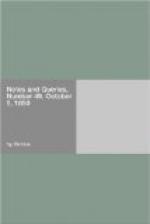Cinderella.—Referring to Vol. ii., p. 214., allow me to ask in what edition of Perrault’s Fairy Tales the misprint of verre from vair first occurs? what is the date of their first publication, as well as that of the translation under the title of Mother Goose’s Tales? whether Perrault was the originator of Cinderella, or from what source he drew the tale? {298} what, moreover, is the authority for identifying sable with vair for the employment of either in designating the highest rank of princesses?
SANDVICENSIS.
Judas’ Bell, Judas’ Candle (Vol. i., pp. 195. 235. 357.).—Some time since I asked the meaning of a Judas’ Bell, and your learned correspondent CEPHAS replied that it was only a bell so christened after St. Jude, the apostle. However, it may have been connected with the Judas’ tapers, which, according, to the subjoined entries, were used with the Paschal candle at Easter. May I trust to his kindness to explain its purport?
“Reading Parish Accompts.
“1499. Itm. payed
for making leng’ Mr. Smyth’s molde wt.
a Judas
for the Pascall—vJd.”
“St. Giles’ Parish Accompts.
“A.D. 1514. Paid for making a Judas for Pascall iiijd.”
“Churchwardens’ Accompts of S. Martin, Outwich.
“1510. Paid to
Randolf Merchaunt Wex Chandiler for the Pascall,
the tapers affore the Rode,
the Cross Candelles, and Judas
Candelles—viiijs.
iiijd.”
“St. Margaret’s, Westminster.
“1524. Item payed
for xij. Judacis to stand with the tapers—O
ijd. O”
MACKENZIE WALCOTT, M.A., Oxon.
Dozen of Bread; Baker’s Dozen.—In the Chronicle of Queen Jane, and of Two Years of Queen Mary, lately printed for the Camden Society (Appendix iv. p. 112.), it is stated that, amongst other particulars in the accounts of the Chamberlain of Colchester, at which place Mary was entertained on her way to London, there is:—“For xxxviii. dozen of bread, xxxixs.” In the language of the county from which I write, “a dozen of bread” was (and I believe is yet) used to express either one loaf, value twelvepence or two loaves, value sixpence each: and even when the sizes and price of the loaves varied, it was used to express the larger loaf, or the two smaller loaves. A dozen of bread was also divided into six twopenny, or twelve penny loaves.
But in the quotation above, thirty-eight dozen of bread are charged thirty-nine shillings; whereas the extra one shilling, cannot be divided into aliquot parts, so as to express the value of each of the thirty-eight dozen of bread.
What was a dozen of bread in 1553?
What is a baker’s dozen, and why so called?
P.H.F.
Kongs skuggsia.—Is anything, precise known of the date and origin of the Icelandic Kongs skuggsia.




